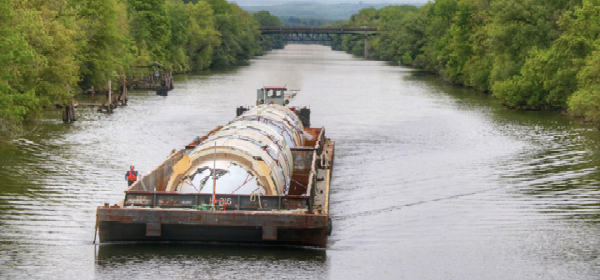Low Bridge, Everybody Down!

As the historic Erie Canal celebrates its 200th anniversary, it’s also enjoying another milestone: commercial traffic volume that’s five times higher than in recent years. Built in 1817 to transport goods and people from one side of New York to the other, today the canal is primarily a recreational waterway.
Commercial volume on the state’s four-canal system five years ago was 43,000 tons, according to the New York State Canal Corporation. Thanks in part to a marketing push, it’s about to hit a record 200,000 tons mid-2017, with much of that coming from aggregate quarry stone bound for construction projects. Higher dollar value but lighter cargo includes turbines and cooling towers.
Until May 2017, the increase in commercial traffic had gone mostly unnoticed by the communities from Albany to Buffalo that sprang up along the Erie Canal in the early 1800s. But this spring, 12 mammoth beer fermentation tanks on four barges moved down the canal and through 33 locks on their way to the Genesee Brewery in Rochester, New York. Residents living near the mostly recreational waterway came out by the thousands, flooding social media with pictures and videos featuring a decidedly modern twist on the old-school transportation mode: a unique #toastthetanks hashtag for the barges.
The 60-foot-high and 20-foot-wide tanks that will hold 2,000 barrels each are part of a $40-million modernization project at one of the largest and oldest continuously operating breweries in the United States. Manufactured in China and transported by ocean, the tanks moved from New York City up the Hudson River to just north of Albany on the eastern side of the Empire State.
Tank manufacturer Lehui Group contracted with logistics company Welton Shipping for the entire move. The canal route for transport to Rochester in Western New York made sense, says Henry Hui, Welton vice president, because the tanks were taller than the 16-foot clearance required for telephone, cable, and electrical lines along highways and railroad tracks. They were almost too tall for the canal, too.
“One of our biggest challenges was sinking the barges low enough to get clearance on bridges because the tanks themselves weren’t very heavy,” says Hui.
Welton added sand and water to weigh down the barges so they could coast under the route’s 226 bridges. Leaving nothing to chance, Hui did a simulation trip before confirming it could be done. “We started planning the logistics for this nine months in advance,” Hui says.
This was Welton’s maiden voyage on the Erie Canal, but with the increased commercial use, it may not be its last.
